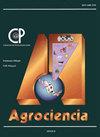球孢白僵菌的生产、毒力和生存力Vuill。由苋菜残茬发酵得到的分生孢子
IF 0.5
4区 农林科学
Q4 AGRICULTURE, MULTIDISCIPLINARY
引用次数: 0
摘要
昆虫病原真菌生物制剂需要具有高毒力的感染单位(分生孢子)的可行浓度。这些主要是通过高碳氮比的农业工业残留物作为基质的固态栽培产生的,例如苋菜残茬(Amaranthus hypochondriacus L.),由于其缺乏收获后的效用而被丢弃在田间,从而成为污染源。因此,与水稻(Oryza sativa)等普通基质相比,使用它可以降低生产成本。本研究的目的是比较苋菜残茬对球孢白僵菌的产生、毒力和生存能力的影响。Vuill。由固态栽培生产的分生孢子到以水稻为基质生产的分生孢子。结果表明,用水稻生产的球孢菌的产量比用苋菜残茬生产的产量高15%。然而,两种底物产生的分生孢子的毒力和活力没有显著差异。因此,与水稻等普通基质相比,利用苋菜残茬生产球孢白僵菌是一种经济的选择。本文章由计算机程序翻译,如有差异,请以英文原文为准。
PRODUCTION, VIRULENCE, AND VIABILITY OF Beauveria bassiana (Bals.) Vuill. CONIDIA OBTAINED BY FERMENTATION OF AMARANTH STUBBLE
Entomopathogenic fungi biological formulations require viable concentrations of infective units (conidia) with high virulence. These are mainly produced by solid-state cultivation of agro-industrial residues with high C/N ratios as substrates, such as amaranth stubble (Amaranthus hypochondriacus L.), which is discarded in the fields due to its lack of postharvest utility and thus becomes a source of contamination. Therefore, its use can reduce production costs when compared to common substrates such as rice (Oryza sativa). The objective of this work was to compare the effect of amaranth stubble on the production, virulence, and viability of Beauveria bassiana (Bals.) Vuill. (Hypocreales: Cordycipitaceae) conidia produced by solid-state cultivation to those produced using rice as a substrate. The results showed that the yield of B. bassiana conidia produced with rice was 15 higher than that produced with amaranth stubble. However, there were no significant differences in the virulence and viability of conidia produced by both substrates. Therefore, the use of amaranth stubble is an economical alternative to produce B. bassiana conidia compared to common substrates like rice.
求助全文
通过发布文献求助,成功后即可免费获取论文全文。
去求助
来源期刊

Agrociencia
农林科学-农业综合
CiteScore
0.50
自引率
33.30%
发文量
51
审稿时长
18-36 weeks
期刊介绍:
AGROCIENCIA is a scientific journal created and sponsored by the Colegio de Postgraduados. Its main objective is the publication and diffusion of agricultural, animal and forestry sciences research results from mexican and foreign scientists. All contributions are peer reviewed. Starting in the year 2000, AGROCIENCIA became a bimonthly and fully bilingual journal (Spanish and English versions in the same issue). Since 2007 appears every month and a half (eight issues per year). In addition to the printed issues, the full content is available in electronic format.
 求助内容:
求助内容: 应助结果提醒方式:
应助结果提醒方式:


